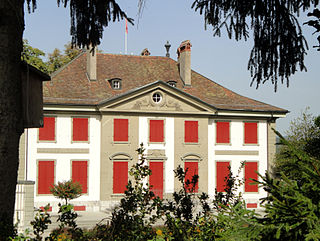Denmark

A manor house was historically the main residence of the lord of the manor in Europe. The house formed the administrative centre of a manor in the European feudal system; within its great hall were held the lord's manorial courts, communal meals with manorial tenants and great banquets. The term is today loosely applied to various country houses, frequently dating from the late medieval era, which formerly housed the gentry.
This is an incomplete list.


|
|
See: List of castles, palaces and manor houses in Germany








A few manors are found in Canada and most are in Quebec:

Frogner is a residential and retail borough in the West End of Oslo, Norway, with a population of 59,269 as of 2020. In addition to the original Frogner, the borough incorporates Bygdøy, Uranienborg and Majorstua. The borough is named after Frogner Manor, and includes Frogner Park. The borough has the highest real estate prices in Norway.

An alcázar, from Arabic al-Qasr, is a type of Islamic castle or palace in Spain built during Muslim rule between the 8th and 15th centuries. They functioned as homes and regional capitals for governmental figures throughout the Umayyad caliphate and later for Christian rulers following the Iberian Reconquista. The term alcázar is also used for many medieval castles built by Christians on earlier Roman, Visigothic or Islamic fortifications and is frequently used as a synonym for castillo or castle. In Latin America there are also several colonial palaces called alcázars.

A manor house was historically the main residence of the lord of the manor. The house formed the administrative centre of a manor in the European feudal system; within its great hall were usually held the lord's manorial courts, communal meals with manorial tenants and great banquets. The term is today loosely applied to various English country houses, mostly at the smaller end of the spectrum, sometimes dating from the Late Middle Ages, which currently or formerly house the landed gentry.

The Royal Sites are a set of palaces, monasteries, and convents built for and under the patronage of the Spanish monarchy. They are administered by Patrimonio Nacional (National Heritage), a Spanish state agency; most are open to the public, at least in part, except when they are needed for state or official events.
An official residence is a residence designated by an authority and assigned to an official, and may be the same place where the office holder conducts their work functions or lives.

Châteauesque is a revivalist architectural style based on the French Renaissance architecture of the monumental châteaux of the Loire Valley from the late fifteenth century to the early seventeenth century.

The Lohn Estate is a manor and estate located in Kehrsatz, canton of Bern, Switzerland. It serves as the official estate of the Swiss Federal Council. From 1942 to 1994, the Lohn Estate accommodated the official guests of the Swiss Confederation, which have included a number of heads of States and royalty. It is a Swiss heritage site of national significance.

The National Romantic style was a Nordic architectural style that was part of the National Romantic movement during the late 19th and early 20th centuries. It is often considered to be a form of Art Nouveau.

The Alcázar of Segovia is a medieval castle located in the city of Segovia, in Castile and León, Spain. It has existed since at least the 12th century, and is one of the most renowned medieval castles globally and one of the most visited landmarks in Spain. It has been the backdrop for significant historical events and has been home to twenty-two kings, along with notable historical figures.

The Royal Alcázar of Madrid was a fortress located at the site of today's Royal Palace of Madrid, Madrid, Spain. The structure was originally built in the second half of the ninth century by the Muslims, then extended and enlarged over the centuries, particularly after 1560. It was at this time that the fortress was converted into a royal palace, and Madrid became the capital of the Spanish Empire. Despite being a palace, the great building kept its original Arabic title of Alcázar.

Schloss Ahrensburg is a former Herrenhaus (mansion) and is today referred to as a Schloss. It is located in Ahrensburg in southern Schleswig-Holstein, Germany, not far from the city of Hamburg.

The Residential Palace Darmstadt is the former residence and administrative seat of the landgraves of Hesse-Darmstadt and from 1806 to 1919 of the Grand Dukes of Hesse-Darmstadt. It is located in the centre of the city of Darmstadt. The palace consists of an older Renaissance part and an 18th century Baroque part.